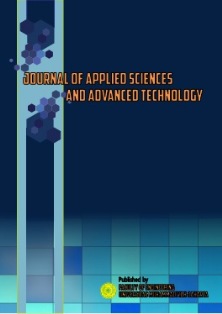Mechanical Properties of Particle board from Empty Palm Fruit with Polyester Resin Adhesive
DOI:
https://doi.org/10.24853/jasat.4.1.35-42Keywords:
Fruit Particleboard Product Polyester ResinAbstract
The need for particleboard in Indonesia is increasing every year. Particleboard is usually made of wood that comes from the forest so it has a bad effect and forest products will decrease over time. To overcome this problem, new knowledge is created that can be done. The new knowledge is like utilizing empty palm oil bunches for particle board material to replace wood raw materials. Particleboard is usually made of wood or other lignocellulosic materials such as oil palm empty bunches. The empty fruit bunches that have been made will be mixed with polyester resin as an adhesive. This study examines the effect of the percentage of polyester resin adhesive used, namely 90%, 75% and 60%. The process of making particle board starts with the preparation of raw materials such as palm empty fruit bunches and polyester resin. For empty bunches fiber used is 1 cm long. After the particle board is made, a hardness test is carried out using a durometer with the ASTM D2240 standard.Downloads
References
Aryafatta. 2008. Processing Palm Oil Waste into Bioethanol.http://aeryafatta.com/2008/06/01/processing-palm-waste-to-bioethanol.html. accessed on 09 september 2019
asroni and nurkholis, 2016. The Effect of Polyester Resin Composition on Hardness and Tensile Strength of Cassava Waste Particle Board Composite. Mechanical Engineering University of Muhammadiyah Metro.
Budiaman, A., Rawenda, & Gustian, R. 2005. Harvesting waste in logging plots in industrial forest plantation concessions at PT Inhutani II and Perum Perhutani KPH Banten. Journal of Forest Products Technology, Vol. 18(2):2637
Darnoko, D. Siahaan, D. Nuryanto, E. Elisabeth, J. Erningpraja, L. Tobing, PL Naibaho, PM Ryanti, H. 2002. Palm Oil Processing Techniques and Its Derivative Products. Medan Oil Palm Research Center.
Hambali, E., Mujdalipah, S., Tambunan, AH, Pattiwiri, AW, and Roy, H.2007. Bioenergy Technology. Agromedia Library. Jakarta.
Holtzapple, MT, RR Davison, LL Lowery Jr, and CB Granda. 2004. Methods and Systems for Pretreatment and Processing of Biomass (US Pat. No. 2004/0168960 A1).
Hermiati, et al. 3003. Efforts to Reduce Impurities and Content of Extractive Substances of Oil Palm Empty Fruit Bunches by Washing, Journal of Tropical Wood Science and Technology Volume 1 MAPEKI. BOGOR.
isroi. Easy Ways to Compost Empty Palm Oil Bunches.http://isroi.com(accessed February 27, 2016)
Murni, R., Suparjo, Akmal and Ginting, DL, 2008. Textbook of waste utilization technology for feed. Food Laboratory, Livestock, Faculty of Animal Husbandry, Jambi University.
Mulyadi, D. (2004) Use of Rattan Fiber as Reinforcement in Composites with Polyester Matrix. Department of Mechanical Engineering FTI-ITB, Bogor.
Roza, irwan. 2009. The Effect of Differences in the Process of Providing Fiber by Mechanical Ways of Oil Palm Empty Fruit Bunches Waste on Fiberboard. Agricultural technology of the Pakayumbuh State Polytechnic.
Rangkuti, Zulkarnain. 2011. Manufacture and Characteristics of Particle Board from a Mixture of Polyester Resin and Corn Skin Fiber. Thesis. North Sumatra University
Subiyanto, B.; Subyakto and S. Kawai. 2002. Zeroemission Processes of Oil Palm Utilization, Case Study of Oil Palm Mill PT Kertajaya Lebak Banten Province. Proceedings of the fourth International Wood Science Symposium, Serpong, pp. 305-311.
Subiyanto. 2004. Wood Waste Disposed of Love. Republika Daily. www.republika.co.id/koran_detail. asp?id=244907&kat_jd=13 [21 April 2015].
Wahyuni, Mardiana. Aerobic Decomposition Rate and Quality of Compost of Oil Palm Empty Fruit Bunches With the Addition of Cellulolytic Microorganisms, Amendments and Palm Oil Mill Liquid Waste. Thesis. Master of Agriculture.University of North Sumatra
Rahardja, I. B., & Ramadhan, A. I. (2019). Pemanfaatan Daun Nangka Kering Sebagai Tempat Alat Tulis Kantor (ATK). Jurnal Pengabdian Masyarakat Teknik, 2(1), 1-6.
Rahardja, I. B., Daraquthni, Z., & Ramadhan, A. I. (2019). Potential of Palm Oil Solid Waste as Steam Power Fuel (Case Study at XYZ Palm Oil Mill). Journal of Applied Sciences and Advanced Technology, 2(2), 33-38.
Rahardja, I. B., Rikman, R., & Ramadhan, A. I. (2018). Analysis of Heat Transfer of Fiber Mesocarp of Palm Oil (Elaeis Guineensis Jacq) as Roof Building. Journal of Applied Sciences and Advanced Technology, 1(1), 1-8.
Rahardja, I. B., Sukarman, S., & Ramadhan, A. I. (2019). Analisis Kalori Biodiesel Crude Palm Oil (CPO) dengan Katalis Abu Tandan Kosong Kelapa Sawit (ATKKS). Prosiding Semnastek.
Rahardja, I. B., Siregar, A. L., & Purwani, S. (2019). Pengaruh Jumlah Lubang pada Body Lori terhadap Perbandingan Oil Losses in Empty Bunch dan Oil in Condensate. Jurnal Citra Widya Edukasi, 11(3), 231-238.
Purwaningrum Pramiati.,”Upaya Mengurangi Timbulan Sampah Plastik Di Lingkungan”,JTL,Vol. 8 No.2, (2016).
Rahardja, I. B., & Masnia, M. (2021). The Optimization of Capacity Boiler Efficiency 26 Tons/Hours with Fuel Alumination and Statistical Product and Service Solutions (Spss) Analysis. ADI Journal on Recent Innovation, 2(2), 113-185.
Wirahadi Michelli,”Elemen Interior Berbahan Baku Pengolahan Sampah Styrofoam dan Sampah Kulit Jeruk”,JI,Vol. 5 No.2, (2017).
Rahardja, I. B., Dinary, R., & Ramadhan, A. I. (2019). Crystal Exergy Value (Wax) Crude Palm Oil (CPO) Influence Based On The Mixed Type. Journal of Applied Sciences and Advanced Technology, 1(3), 91-98
Downloads
Published
Issue
Section
License
COPYRIGHT POLICY
The author(s) of an article published in the Journal of Applied Sciences and Advanced Technology (JASAT) retains ownership of the intellectual property rights in work (s).
PUBLISHING RIGHTS
The author(s) of an article published in the Journal of Applied Sciences and Advanced Technology (JASAT) have unrestricted publication rights. The authors give the Journal of Applied Sciences and Advanced Technology (JASAT) the right to publish the article and designate the Faculty of Engineering Universitas Muhammadiyah Jakarta Publishing as the original publisher of the article.
LICENSING POLICY
JASAT is an open-access journal that follows the Creative Commons Non-Commercial 4.0 International License (CC BY-NC 4.0), which states that:

Under this license, the reusers must give appropriate credit, provide a link to the license, and indicate if changes were made. Users may do so in any reasonable manner, but not in any way that suggests the licensor endorses users or their use.
Please take the time to read the whole license agreement (https://creativecommons.org/licenses/by-nc/4.0/). As long as reusers follow the license conditions, the owner cannot withdraw these freedoms. The following components are included under this license:
 Attribution: Users must provide appropriate attribution, including a link to the license, and indicate whether or not they made any modifications. Users are free to do so reasonably, but not in a manner that indicates the licensee approves of their usage.
Attribution: Users must provide appropriate attribution, including a link to the license, and indicate whether or not they made any modifications. Users are free to do so reasonably, but not in a manner that indicates the licensee approves of their usage.
 NonCommercial: Users may not use the material for commercial purposes.
NonCommercial: Users may not use the material for commercial purposes.












_2.png)


1.png)

2.png)
